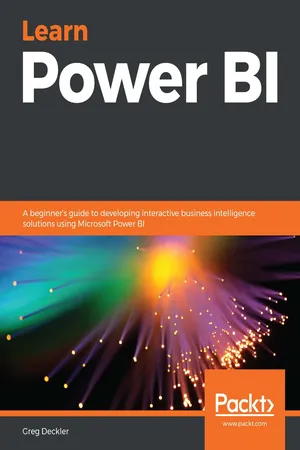
Learn Power BI
A beginner's guide to developing interactive business intelligence solutions using Microsoft Power BI
- 362 pages
- English
- ePUB (mobile friendly)
- Available on iOS & Android
Learn Power BI
A beginner's guide to developing interactive business intelligence solutions using Microsoft Power BI
About this book
Solve business challenges with Microsoft Power BI's advanced visualization and data analysis techniques
Key Features
- Create effective storytelling reports by implementing simple-to-intermediate Power BI features
- Develop powerful analytical models to extract key insights for changing business needs
- Build, publish, and share impressive dashboards for your organization
Book Description
To succeed in today's transforming business world, organizations need business intelligence capabilities to make smarter decisions faster than ever before. This Power BI book is an entry-level guide that will get you up and running with data modeling, visualization, and analytical techniques from scratch.
You'll find this book handy if you want to get well-versed with the extensive Power BI ecosystem. You'll start by covering the basics of business intelligence and installing Power BI. You'll then learn the wide range of Power BI features to unlock business insights. As you progress, the book will take you through how to use Power Query to ingest, cleanse, and shape your data, and use Power BI DAX to create simple to complex calculations. You'll also be able to add a variety of interactive visualizations to your reports to bring your data to life. Finally, you'll gain hands-on experience in creating visually stunning reports that speak to business decision makers, and see how you can securely share these reports and collaborate with others.
By the end of this book, you'll be ready to create simple, yet effective, BI reports and dashboards using the latest features of Power BI.
What you will learn
- Explore the different features of Power BI to create interactive dashboards
- Use the Query Editor to import and transform data
- Perform simple and complex DAX calculations to enhance analysis
- Discover business insights and tell a story with your data using Power BI
- Explore data and learn to manage datasets, dataflows, and data gateways
- Use workspaces to collaborate with others and publish your reports
Who this book is for
If you're an IT manager, data analyst, or BI user new to using Power BI for solving business intelligence problems, this book is for you. You'll also find this book useful if you want to migrate from other BI tools to create powerful and interactive dashboards. No experience of working with Power BI is expected.
Frequently asked questions
- Essential is ideal for learners and professionals who enjoy exploring a wide range of subjects. Access the Essential Library with 800,000+ trusted titles and best-sellers across business, personal growth, and the humanities. Includes unlimited reading time and Standard Read Aloud voice.
- Complete: Perfect for advanced learners and researchers needing full, unrestricted access. Unlock 1.4M+ books across hundreds of subjects, including academic and specialized titles. The Complete Plan also includes advanced features like Premium Read Aloud and Research Assistant.
Please note we cannot support devices running on iOS 13 and Android 7 or earlier. Learn more about using the app.
Information
Section 1: The Basics
- Chapter 1, Introduction to Business Intelligence and Power BI
Introduction to Business Intelligence and Power BI
- Key concepts of business intelligence
- The Power BI ecosystem
- Power BI licensing
- Power BI Desktop and Power BI Service
Key concepts of business intelligence
- How can the business attract new customers?
- How can the business retain more customers?
- Who are the competitors and how do they compare?
- What is driving profitability?
- Where can expenses be diminished?
- Domain
- Data
- Model
- Analysis
- Visualization
Domain
- Sales
- Marketing
- Manufacturing/production
- Logistics
- Research and development
- Purchasing
- Human resources
- Accounting/finance
Data
Internal and external data
Structured, unstructured, and semi-structured data
Model
Organizing
Table of contents
- Title Page
- Copyright and Credits
- About Packt
- Contributors
- Preface
- Section 1: The Basics
- Introduction to Business Intelligence and Power BI
- Section 2: The Desktop
- Up and Running with Power BI Desktop
- Connecting and Shaping Data
- Creating Data Models and Calculations
- Unlocking Insights
- Creating the Final Report
- Section 3: The Service
- Publishing and Sharing
- Using Reports in the Service
- Understanding Dashboards, Apps, and Security
- Data Gateways and Refreshing Datasets
- Other Books You May Enjoy